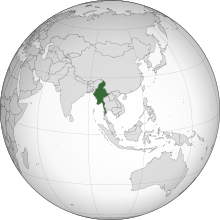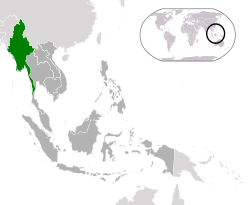**Geography and Early Civilizations**:
– Myanmar is the largest country in Mainland Southeast Asia.
– It shares borders with Bangladesh, India, China, Laos, and Thailand.
– The capital city is Naypyidaw, while the largest city is Yangon.
– Early civilizations in the area included the Pyu city-states in Upper Myanmar and the Mon kingdoms in Lower Myanmar.
– The country has a diverse geography, including mountains, plains, and coastal regions.
– Evidence of Homo erectus living in Myanmar dates back to 750,000 years ago.
– Homo sapiens first appeared around 25,000 BP in central Myanmar.
– Neolithic age domestication of plants and animals occurred between 10,000 and 6,000 BCE.
– Bronze Age began around 1500 BCE with copper turning into bronze.
– Iron Age settlements emerged around 500 BCE, engaging in trade with China.
**History and Dynasties**:
– The Bamar people entered the upper Irrawaddy valley in the 9th century.
– The Pagan Kingdom was established in the 1050s, promoting Burmese language, culture, and Theravada Buddhism.
– The 19th-century saw British colonization of Myanmar after three Anglo-Burmese Wars.
– Post-independence, Myanmar has faced ongoing unrest, conflict, and military rule.
– In recent years, there have been significant political transitions and international tensions.
– The Taungoo Empire emerged in the mid-16th century under King Tabinshwehti.
– The Konbaung Dynasty succeeded the Toungoo Dynasty in the 18th century.
– Myanmar became one of the world’s most impoverished countries during the Ne Win Years (1962-1988).
– General Saw Maung staged a coup d’état in 1988, leading to a period of military rule.
– The National League for Democracy (NLD) won elections in 1990, but the military junta refused to cede power.
**Economy and Development**:
– Myanmar is rich in natural resources like jade, gems, oil, and natural gas.
– The country also has renewable energy potential, particularly in solar power.
– However, instability, corruption, and poor infrastructure have hindered economic development.
– The income gap in Myanmar is one of the widest globally.
– As of 2020, Myanmar ranks low in human development compared to other Southeast Asian countries.
**Humanitarian Situation and Ethnic Strife**:
– Since 2021, over 600,000 people have been displaced in Myanmar due to post-coup violence.
– More than 3 million people are in urgent need of humanitarian assistance.
– The country has a long history of ethnic strife and civil wars.
– Human rights violations have been consistently reported by the United Nations and other organizations.
– The Rohingya conflict remains a significant international concern.
– Civil wars have been ongoing since Myanmar’s independence in 1948, including conflicts like the Kachin conflict and the Shan-Lahu-Karen conflict.
**Modern Era and Political Transitions**:
– Transitioned from military rule to a civilian government in 2011.
– National League for Democracy won the 2015 general elections.
– Aung San Suu Kyi became State Counsellor in 2016.
– The Rohingya crisis led to international criticism.
– A military coup in 2021 led to widespread protests.
Myanmar, officially the Republic of the Union of Myanmar and also known as Burma (the official name until 1989), is a country in Southeast Asia. It is the largest country by area in Mainland Southeast Asia and has a population of about 55 million. It is bordered by Bangladesh and India to its northwest, China to its northeast, Laos and Thailand to its east and southeast, and the Andaman Sea and the Bay of Bengal to its south and southwest. The country's capital city is Naypyidaw, and its largest city is Yangon (formerly Rangoon).
Republic of the Union of Myanmar
| |
|---|---|
| Anthem: ကမ္ဘာမကျေ Kaba Ma Kyei "Till the End of the World" | |
| Capital | Naypyidaw 21°00′N 96°00′E / 21.000°N 96.000°E |
| Largest city | Yangon |
| Official language | Burmese |
| Recognised regional languages | |
| Ethnic groups (2018) | |
| Religion |
|
| Demonym(s) |
|
| Government | Unitary assembly-independent republic under a military junta |
| Myint Swe (acting) | |
• SAC Chairman and Prime Minister | Min Aung Hlaing |
| Soe Win | |
| Legislature | State Administration Council |
| Formation | |
| 23 December 849 | |
| 16 October 1510 | |
| 29 February 1752 | |
| 1 January 1886 | |
| 4 January 1948 | |
| 2 March 1962 | |
• Renamed from "Burma" to "Myanmar" | 18 June 1989 |
| 30 March 2011 | |
| 1 February 2021 | |
| Area | |
• Total | 676,579 km2 (261,229 sq mi) (39th) |
• Water (%) | 3.06 |
| Population | |
• 2022 estimate | 57,526,449 (26th) |
• Density | 196.8/sq mi (76.0/km2) (125th) |
| GDP (PPP) | 2023 estimate |
• Total | |
• Per capita | |
| GDP (nominal) | 2023 estimate |
• Total | |
• Per capita | |
| Gini (2017) | medium |
| HDI (2022) | medium (144th) |
| Currency | Kyat (K) (MMK) |
| Time zone | UTC+06:30 (MMT) |
| Driving side | right |
| Calling code | +95 |
| ISO 3166 code | MM |
| Internet TLD | .mm |
Early civilisations in the area included the Tibeto-Burman-speaking Pyu city-states in Upper Myanmar and the Mon kingdoms in Lower Myanmar. In the 9th century, the Bamar people entered the upper Irrawaddy valley, and following the establishment of the Pagan Kingdom in the 1050s, the Burmese language, culture, and Theravada Buddhism slowly became dominant in the country. The Pagan Kingdom fell to Mongol invasions, and several warring states emerged. In the 16th century, reunified by the Taungoo dynasty, the country became the largest empire in the history of Southeast Asia for a short period. The early 19th-century Konbaung dynasty ruled over an area that included modern Myanmar and briefly controlled Manipur and Assam as well. The British East India Company seized control of the administration of Myanmar after three Anglo-Burmese Wars in the 19th century, and the country became a British colony. After a brief Japanese occupation, Myanmar was reconquered by the Allies. On 4 January 1948, Myanmar declared independence under the terms of the Burma Independence Act 1947.
Myanmar's post-independence history has continued to be checkered by unrest and conflict. The coup d'état in 1962 resulted in a military dictatorship under the Burma Socialist Programme Party. On 8 August 1988, the 8888 Uprising then resulted in a nominal transition to a multi-party system two years later, but the country's post-uprising military council refused to cede power, and has continued to rule the country through to the present. The country remains riven by ethnic strife among its myriad ethnic groups and has one of the world's longest-running ongoing civil wars. The United Nations and several other organisations have reported consistent and systemic human rights violations in the country. In 2011, the military junta was officially dissolved following a 2010 general election, and a nominally civilian government was installed. Aung San Suu Kyi and political prisoners were released and the 2015 Myanmar general election was held, leading to improved foreign relations and eased economic sanctions, although the country's treatment of its ethnic minorities, particularly in connection with the Rohingya conflict, continued to be a source of international tension and consternation. Following the 2020 Myanmar general election, in which Aung San Suu Kyi's party won a clear majority in both houses, the Burmese military (Tatmadaw) again seized power in a coup d'état. The coup, which was widely condemned by the international community, led to continuous ongoing widespread protests in Myanmar and has been marked by violent political repression by the military, as well as a larger outbreak of the civil war. The military also arrested Aung San Suu Kyi in order to remove her from public life, and charged her with crimes ranging from corruption to the violation of COVID-19 protocols; all of the charges against her are "politically motivated" according to independent observers.
Myanmar is a member of the East Asia Summit, Non-Aligned Movement, ASEAN, and BIMSTEC, but it is not a member of the Commonwealth of Nations despite once being part of the British Empire. Myanmar is a Dialogue Partner of the Shanghai Cooperation Organization. The country is very rich in natural resources, such as jade, gems, oil, natural gas, teak and other minerals, as well as also endowed with renewable energy, having the highest solar power potential compared to other countries of the Great Mekong Subregion. However, Myanmar has long suffered from instability, factional violence, corruption, poor infrastructure, as well as a long history of colonial exploitation with little regard to human development. In 2013, its GDP (nominal) stood at US$56.7 billion and its GDP (PPP) at US$221.5 billion. The income gap in Myanmar is among the widest in the world, as a large proportion of the economy is controlled by cronies of the military junta. Myanmar is one of the least developed countries; as of 2020, according to the Human Development Index, it ranks 147 out of 189 countries in terms of human development, the lowest in Southeast Asia. Since 2021, more than 600,000 people were displaced across Myanmar due to the surge in violence post-coup, with more than 3 million people in dire need of humanitarian assistance.




